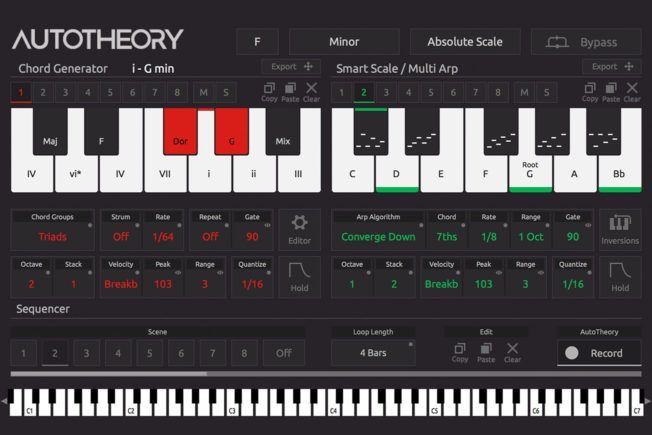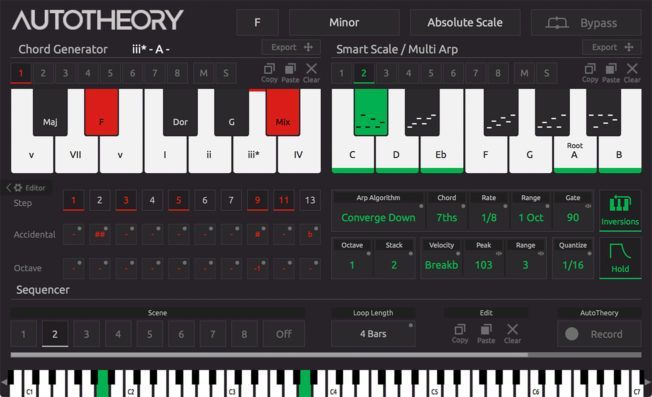This plugin spotlight looks at AutoTheory 4 by Mozaic Beats. This composition software helps you create chords and melodies without any music theory experience.

AutoTheory 4 Review
AutoTheory 4 enables musicians to play chords and melodies in perfect key without knowing music theory. This innovative composition software makes it easy to create chord progressions, melodies, basslines, and arpeggios.
Moreover, AutoTheory 4 makes it easy to play in harmony. Choose a key and scale, and the software will map all relevant chords and notes to the keys of your keyboard.
AutoTheory 4 is not a plugin. It is a standalone application that syncs with your DAW. This clever sequencer features a selection of MIDI effects and editing tools. Connect a MIDI keyboard or use your QWERTY keyboard to control up to eight instruments.
Whether you’re a beginner or a seasoned pro, AutoTheory 4 will help you hone your music theory skills. The intuitive interface improves workflow and makes learning music theory easier. It shows you how harmony and melody work together. Discover endless chord variations and melody combinations. It also helps you create with confidence, regardless of musical theory or keyboard training.
Global Parameters

Set your desired key, scale, and mapping settings from the global controls. These settings apply to both the Chord Generator and Scale/Multi Arp. The functions also provide a wide range of options to customize your workflow.
Chord Generator
The Chord Generator allows users to play full chords with a single key. Generate simple or complex chords with one finger. There’s a big keyboard display to select or jam chords on the fly. This section also provides several features to define, alter, and sequence chords.
Choose different chord types, modify their behavior, adjust note voicings, and more. You can also create scales or select one from the many provided. After you customize your chord progressions, record them with the sequencer and export the results.
Chord Editor
The Chord Editor feature allows you to edit each chord on a step by step basis. This section offers advanced features to customize the tones of each chord. You can change chord voicings, inversions, extensions, octaves, and more with step parameters.
Smart Scale / Multi Arp
The right side of the interface features the Smart Scale / Multi Arp. This section is for playing melodies. Use your left hand to play chords and your right hand to play melodies. It also provides several features to define, modify, and sequence melodies.
The Smart Scale arranges the seven scale tones based on the selected Mapping. The notes on the right side will always be in key with the chords. AutoTheory 4 will remap these notes to match your chords. This seamless interaction makes it easy to create chord progressions and melodies that harmonize.
The Multi Arp function displays different arpeggio patterns on each black key. The patterns use notes from the same scale as the chords. Each black key also has its own separate set of arpeggio parameters. You can program and edit different arpeggios for each chord.
Sequencer
The Sequencer allows you to record chord progressions, arpeggios, melodies, and basslines. Record multiple tracks and scenes without hassle. You can also change parameter settings after recording. This ability makes it easy to create and edit loops before exporting.
In addition, AutoTheory 4 will sync the Chord Generator and Smart Scale/Multi Arp once recording begins. A MIDI Beat Clock will also keep the sequencer in sync with your DAW.
MIDI Outputs
The MIDI Outputs connect up to eight instruments in your DAW. AutoTheory 4 receives MIDI from your connected keyboard, controller, or QWERTY keyboard. It then sends the output to eight “virtual midi controller” tracks in your DAW. You can activate and assign these outputs to any instrument.
Key Features
- Chord Generator: One Finger Chords from Multiple Groups with Strum, Repeat and Velocity Effects.
- Smart Scale: Keep your hand in the same position while the scale transposes to each Chord Selection.
- Multi Arp: Improvise through multiple one finger arpeggios of the current chord.
- Chord Editor: Customize tones within each chord for unique voicings, inversions, and extended chords.
- Device Outputs: Control multiple instruments simultaneously from a single keyboard or qwerty.
- Sequencer: Record multiple tracks & scenes before altering key and other parameters post-recording.
Pricing and Availability
AutoTheory 4 is available for $99. AutoTheory Pro users can upgrade for $29.99.

Turn your passion for music into a Profession: Learn more about our Music School Programs!
MORE ARTICLES FROM THE ICON BLOG

FIND YOUR SOUND, HONE YOUR CRAFT:
Are you ready to turn music into a career? ICON prepares students to become music producers, composers, performers, recording artists, professional DJs, and entrepreneurs in the entertainment industry. Click below to get information about our award-winning programs:

